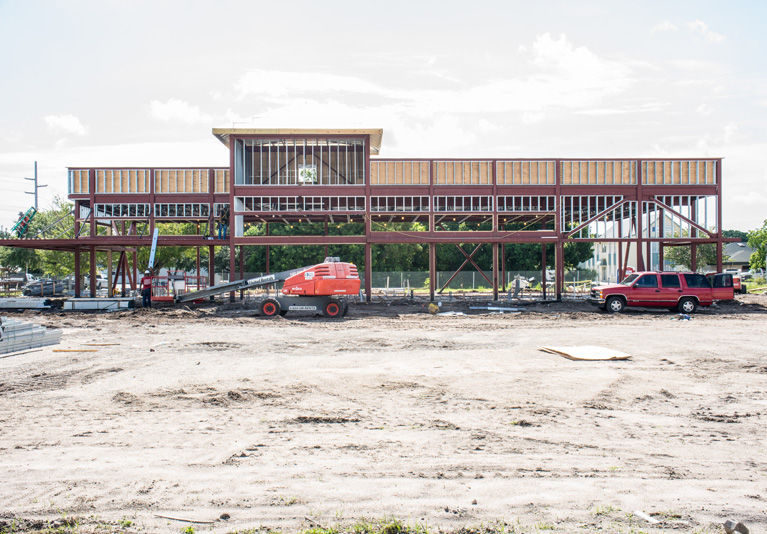
VERO BEACH — Some of you might’ve noticed the new right-turn lane on northbound U.S. 1, immediately south of the Wawa convenience store and gas station under construction on the southeast corner of the 12th Street intersection.
The turn-in lane, built by Wawa in accordance Florida Department of Transportation requirements, is the most obvious traffic-engineering improvement made thus far to accommodate increasing traffic along U.S. 1 – between 20th Street and 8th Street – as the corridor experiences a commercial rebirth.
It won’t be the last.
In fact, local drivers also can expect to see changes in the timing of traffic-signal cycles as new businesses open along that stretch of U.S. 1.
“We’ll look at the volume of traffic and which way it’s turning, and we’ll adjust the timing of the traffic signals as needed,” County Traffic Engineer Kim Graham said. “We have a special software program that looks at the traffic flow at each intersection and calibrates the best way to alleviate it.
“Where necessary, we’ll adjust the cycle lengths to keep traffic flowing as best we can,” she added. “We don’t want people waiting too long.”
Given Wawa’s popularity elsewhere in America, Graham is expecting traffic in and around the intersection of U.S. 1 and 12th Street to surge, possibly beyond the increases seen at the intersection of U.S. 1 and 17th Street – a primary route used by people leaving the barrier island and the site of the recently opened, 5,000-square-foot Cumberland Farms store on the southeast corner, where motorists will find 16 gas pumps.
“We’ve already seen an impact there with occasional backups, especially around lunch time, so we’ll also be looking at the times of day when the volume of traffic is higher,” Graham said. “But you always expect a surge when something new opens, particularly with a store like that.
“You’ll notice the gas prices are pretty low at that new Cumberland Farms, and that’s bringing in a lot of customers,” she added. “After a while, it’ll probably level off.”
The new Wawa, located less than a mile to the south, is projected to stimulate a similar – if not greater – surge in traffic on the already busy highway when it opens. The site of the multi-service convenience store and gas station is diagonally across U.S. 1 from a heavily trafficked shopping plaza that includes Publix, Stein Mart, Starbucks and Carrabba’s Italian Grill.
Just south of Wawa, a 23,000-square-foot retail development is going in with a national auto parts dealer, a Goodwill store, a restaurant and, possibly, a cellphone store.
There are also new businesses coming to the Kmart Plaza at the intersection of U.S. 1 and 15th Place: A Moe’s Southwest Grill already is under construction at the northeast corner of the property and is expected to open in a few months.
In addition, a Vittorio’s Pizzeria & Restaurant, Mattress One store and a salon are expected to move into the Kmart-anchored shopping center.
Traffic volume on U.S. 1 is expected to increase north of 17th Street, too.
Ay! Jalisco, a popular Mexican restaurant, is moving from its longtime Miracle Mile location in the Publix shopping center to the site of the now-closed Vero Beach Sports Grille at 1902 U.S., and a Walmart Neighborhood Market is scheduled to open next year in the abandoned Albertson’s supermarket, which closed in 2012.
And if that’s not enough: BurgerFi – a fast-growing, West Palm Beach-based, gourmet hamburger chain – hopes to start construction on a yet-to-be-determined site along the U.S. 1 corridor in the coming months, with the restaurant expected to open in 2017.
“This is going to be an ongoing situation,” Graham said. “As new businesses open in that area, it’s going to impact the flow of traffic, especially during the busy winter season.
What we won’t see – not any time soon, anyway – is a widening of U.S. 1 in that area.
According to Phil Matson, staff director of the county’s Metropolitan Planning Organization, traffic volume along that stretch of U.S. 1 is only at 60 percent of capacity, despite the fact it sometimes backs up at rush hour such that cars can’t proceed when a light turns green because the block ahead is full of cars.
“We don’t see us exceeding the level of service on U.S. 1 in the foreseeable future, even with the new commercial development,” Matson said. “And if we do eventually get to a point where we’re nearing capacity, we have a silver bullet – Indian River Boulevard, which functions as a bypass for U.S. 1.
“Unlike Palm Bay or Fort Pierce, our north-south corridor isn’t just one four-lane road with suicide lanes,” he added. “We have two [north-south roads]. That’s why I’ve never really worried about having to widen U.S. 1.”
Should it become necessary to widen U.S. 1 to six lanes – three in each direction – Matson said there probably is enough right-of-way to do so, though the center turning lane would probably be removed.
Such a project would be “astronomically expensive,” he said.
“Fortunately, I don’t see that happening any time soon,” Matson said. “I lose sleep over a lot of roads, but that’s not one of them.”



